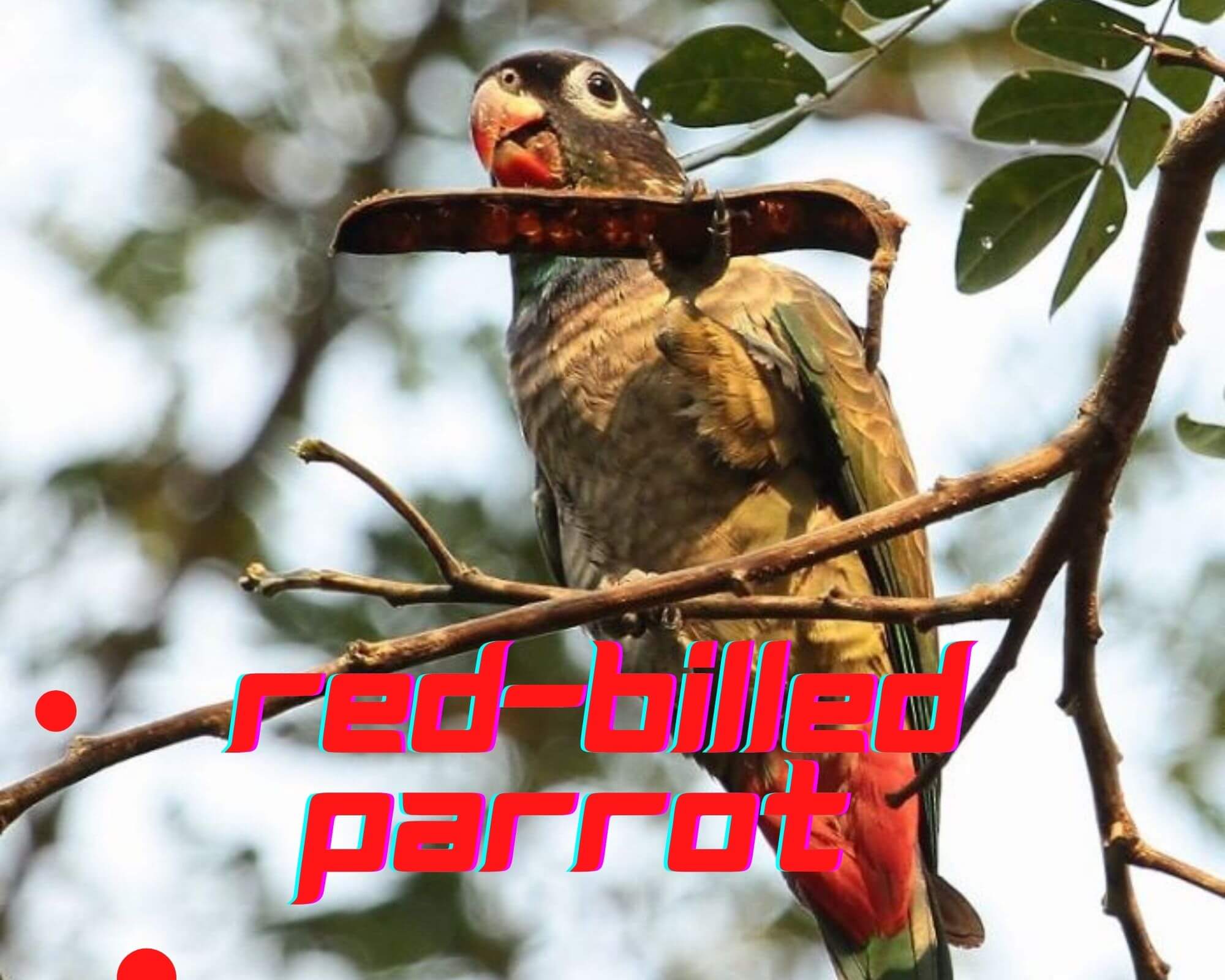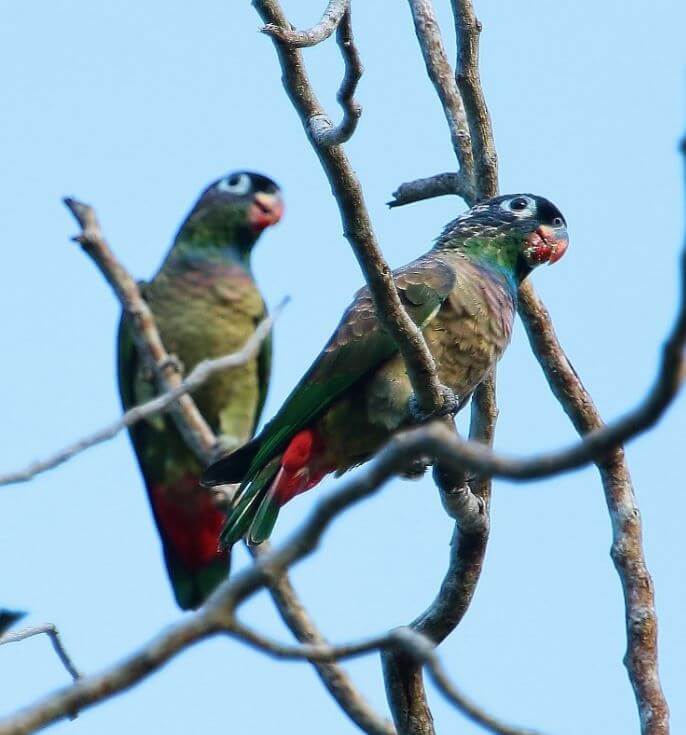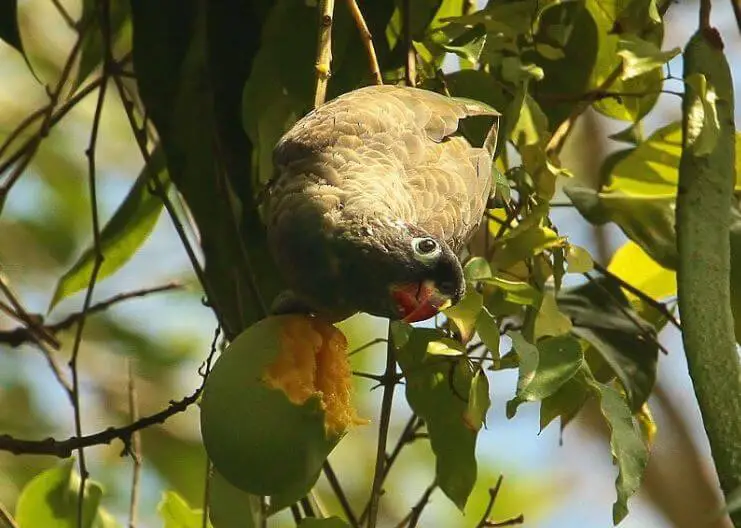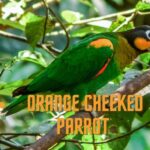 Six subspecies of the Red-billed Parrot are usually recognized across the species’ range, which is somewhat discontinuous, from northern Venezuela to northern Bolivia, principally along the east slope of the Andes, although there are isolated populations elsewhere, for example in western Ecuador and in the Santa Marta Mountains of northern Colombia.All of the different races are generally characterized in being dull green above, becoming somewhat buffier below, with variable amounts of blue on the head and breast, a red ventral patch, and an obvious reddish bill.The Red-billed Parrot has undoubtedly declined in at least some parts of its range, especially perhaps in northern Venezuela and western Ecuador, but it nonetheless can persist in areas with moderate disturbance, and the species remains distinctly numerous in some regions.
Six subspecies of the Red-billed Parrot are usually recognized across the species’ range, which is somewhat discontinuous, from northern Venezuela to northern Bolivia, principally along the east slope of the Andes, although there are isolated populations elsewhere, for example in western Ecuador and in the Santa Marta Mountains of northern Colombia.All of the different races are generally characterized in being dull green above, becoming somewhat buffier below, with variable amounts of blue on the head and breast, a red ventral patch, and an obvious reddish bill.The Red-billed Parrot has undoubtedly declined in at least some parts of its range, especially perhaps in northern Venezuela and western Ecuador, but it nonetheless can persist in areas with moderate disturbance, and the species remains distinctly numerous in some regions.
Red-billed Parrot 28 cm; 272 g. Entire head dull green heavily edged dull blue; bare orbital ring greyish; bill red; upper breast dull blue, with blue scaling on green below, shading to pink-tinged buff-olive on belly; back, wings and tail olive-green, latter with blue outer feathers; under tail-coverts and base of tail dull red.

Red-billed Parrot
Immature green on head and breast, under tail-coverts yellowish green. Race Intelius paler with a little blue on breast; saturatus darker and ponsi darker still; corallinus larger and greener, mantle and back tinged grey and blue; mindoensis like corallinus bit yellower.
Systematics History
Editor’s Note: This article requires further editing work to merge existing content into the appropriate Subspecies sections. Please bear with us while this update takes place.
DNA data indicate that this species is sister to P. maximiliani, with P. fuscus sister to that pair. Race mindoensis considered inseparable from corallinus by some authors but appears worthy of recognition. Six subspecies were recognized.

Subspecies
Pionus sordidus antelius Scientific name definitions
Distribution
Pionus sordidus sordidus Scientific name definitions
Distribution
Pionus sordidus ponsi Scientific name definitions
Distribution
Pionus sordidus saturatus Scientific name definitions
Distribution
Pionus sordidus corallinus Scientific name definitions
Distribution
Pionus sordidus mindoensis Scientific name definitions
Distribution
Distribution
Editor’s Note: Additional distribution information for this taxon can be found in the ‘Subspecies’ article above. In the future, we will develop a range-wide distribution article.
Habitat
Humid and wet submontane and lowland evergreen and semi-deciduous forest, cloud forest and gallery woodland, forest borders, secondary growth, coffee plantations, and adjacent clearings, mostly at 500–1500 m, but range 100–2400m.
Movement
Local movements occur in the dry season at Rancho Grande, N Venezuela, but only when little wind, suggesting bird poorly adapted for long-distance daily displacements.
Diet and Foraging
No specific information; fruits and blossoms were mentioned.

Sounds and Vocal Behavior
Several flight calls were described, apparently with a regional difference. Common calls include a strident “kee!-yak” (subspecies sordidus and Anatolius), an up-slurred “crree!” and a more mellow “crrah” (subspecies corallinus and mindoensis ). When perched, has a wider variety of calls with similar tonal quality.
Breeding
Feb–Apr in Colombia; Apr in Venezuela; Jan–May in Ecuador; Oct in Bolivia. Nest in a hole in a tree, in one case 6 m from the ground, once in 4 m high rotten stump.
In captivity three eggs, size 33 mm × 27·7 mm, and three nestlings recorded in the wild; incubation lasts c. 27 days, nestling period 12 weeks.
Conservation Status
Not globally threatened. CITES II. Fairly common in most of the range, perhaps less numerous in W Ecuador but one of commonest parrots at 2000 m in La Paz, N Bolivia.
Forest clearance in Venezuela and Colombia will have caused long-term local declines and all three races in Venezuela are under pressure, while race Intelius is not found in a recent survey of its much-cleared habitat. Generally, however, the species persists in moderately disturbed habitats. Little traded anywhere.




















